Abstract
The modern economic system has changed, and using classical methods of enterprise management no longer seems to be an effective strategy. The new direction of development, the knowledge economy, is focused on the integration of classical economic knowledge with the development of technological and human capital. This paper examined the example of Apple, which has shown excellent resilience to external and internal limiting factors. The company was found to be open to innovation and, along with technological progress, ready to embody the theories of the knowledge economy.
This report has consistently discussed the key socio-economic, macroeconomic, technological, demographic, legal, and political aspects that limit the company’s free activity. It has been shown that Apple responds to environmental factors in a sustainable and timely manner and therefore has high brand vitality.
Introduction
Throughout human history, individuals and groups have made repeated attempts to create businesses that would be commercially successful. For example, in ancient times, traders exchanged economically valuable products for similarly valued goods when the commodity-money economic model was not yet widespread. Civilizations evolved, and at the same time, approaches to selling and managing production changed. A significant contribution to the development of economic models was made by the industrial age, which initiated technological progress and launched a scientific and production revolution in the world.
As a result, today’s global business industry has since had a strong focus on technology and the use of electronic devices, whether individual consumption or a b2b vector. In more detail, economic progress has traditionally been linked to shifts in the external environment of the industry. In this sense, it is appropriate to assert a causal relationship controlling these mechanisms. An individual business enterprise develops on a ready-made market foundation in response to existing consumer demand.
To increase the competitiveness and sustainability of the firm, management initiates risky development aimed at achieving a leadership position in the industry, which in turn has the potential to cause a shift in the entire market. Such shifts, whether technological, ethical or legal, can guide the initiating company and force competitors to either follow the trends developed or develop their own advantages.
The very idea of technology itself is no longer something of a surprise in today’s marketplace, and on the contrary, its active adoption to streamline operational processes is visibly encouraged by communities. Technological tools for use no longer include elitist mechanisms of social division but are becoming available to a growing stratum of society. Thus, the modern user with a smartphone and a laptop can use technologies that were only available to the military just a few decades ago.
Consequently, the development of technology is connected not only with the development of human thought in general but also with a change in social attitudes in particular. So an economic study of the technology company most represented in society is crucial for assessing the degree of industrial development and the dependence of a particular company on socioeconomic demands.
There is no doubt that one of the most successful and popular companies is the one that resonates most in the minds of consumers as well as in the stock markets. A critical examination of existing data reveals that such a company in the technology industry is Apple, Inc (hereafter simply Apple). This data has been corroborated both by public opinion surveys of brand awareness (Figure 1) and by the inclusion of this company in the ratings of the most quoted securities (Reiff, 2021).
In other words, a detailed study of this company, including an extensive review of aspects from brand history to the socioeconomic factors driving the business agenda, is a priority for a valuable synthesis economic report. This research paper aims to critically analyze the selected company in light of internal and external factors governing management policies and market presence. The report is a valuable material for those interested both in analyzing Apple’s business activities and in examining the influencing factors in general that have regulatory effects on today’s technology organization.
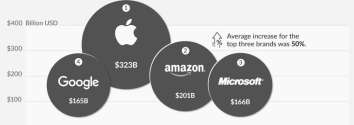
An Overview of Apple
For a more detailed look at the managerial and political features of Apple, it is appropriate to conduct a brief retrospective analysis of its history, allowing the reader to delve deeper into the driving forces and motivations behind specific decisions. As an organization, Apple publicly began its journey on April 1, 1976, with an initial concept and strategic vision very different from the current one (Rawlinson, 2017). This can be shown, including through a review of the brand logo, which featured Isaac Newton by Ronald Wayne against a modern-day overbite apple.
A month later, the company introduced its first product: it was the Apple I desktop computer, which, however, was almost nothing special, but its sales catalyzed the launch of the Apple II, which had technical and price advantages over its competitors. Since then, the company has changed its presence in the market several times (including through the logo) and released several products that were aimed at wide publicity: the Apple Lisa, the Macintosh.
The period of Steve Jobs’ dismissal from the company’s management was marked by severe financial, reputational, and intellectual losses associated with John Scully’s mismanagement and mass-market focus. Once Jobs returned to Apple along with design engineer Joni Ive, the company returned to its former successes and even managed to multiply them. This era saw the launch of one of the most recognizable computers of all time, the translucent blue iMac, the portable iPod player, and the launch of subscription-based online services, including iTunes and Apple TV. A particular milestone in the development of the company, which, one might say, was a turning point in the history of the brand, was the release of the first iPhone in 2007, which had a rare at the time touch screen and a completely new operating system. Subsequently, under the leadership of Jobs released the first iPad, which served as the starting point for the launch of the entire line of smart tablets.
Since then, a little more than ten years have passed, and every year Apple presents revolutionary new products worthy of the trust and interest of users. To date, there have been twelve generations of smartphones, each of which is constantly at the forefront of significant technology rankings. In parallel, the company is developing MacBook, iPad, Apple Watch, and AirPods, creating an integral and independent Apple ecosystem. There is no reason to believe that this company will be in crisis in the coming decade because even during the global pandemic, which destroyed international supply chains and suspended business processes in all countries, Apple has shown record financial success (Higgins, 2020).
By now, the company continues to develop its existing device lines and is additionally developing innovations in other vectors, such as AR, the auto industry, and wireless technology (Nellis, 2020). Taken together, all of this leads the reader to understand that Apple is a major technology player in the industry market, setting trends and actively responding to existing social and market demands.
Determining Socioeconomic Factors
An intriguing thought that characterizes the structure of the modern business is the recognition of the duality of the business-customer relationship. Undoubtedly, providing the customer with the opportunity to purchase a product is a valuable and perhaps key criterion for success in the marketplace. However, of equal importance is the reciprocal ability of the customer to shape the structure and culture of the enterprise. As a multinational company with widespread influence and, as a result, responsibility, Apple is highly dependent on the socioeconomic agenda of society as a whole and the cultural practices of individual regions. This section discusses the major factors governing and guiding the company’s business strategy.
Currency Dynamics
Although Apple began as a U.S. technology provider of computer equipment, it quickly became a multinational conglomerate. By now, about 60 percent of the company’s sales come from foreign markets, according to its annual financial report (Apple Inc., 2020). The expansion of presence in the markets of developed and developing countries, in turn, involves a serious problem of an economic crisis in the regions, since the strengthening of the dollar is associated with a weakening of the local currency, and thus a cheapening of the delivered product. Consequently, one of the critical aspects of Apple’s business strategy is currency risks, which govern the company’s financial policy.
Currency risks should be understood to mean any financial losses that the company may incur as a result of changes in currency exchange rates relative to the original value of the product. Thus, even though Apple is of American origin, the company has no interest in a substantial strengthening of the U.S. dollar in the currency arena. It should be made clear, then, that only a harmonious balance and stability of currency ratios are objects of interest to the company.
Labor Costs
The second aspect that determines the activity of Apple is the cost of labor. It is known that it is a frequent practice for multinational companies to use cheap labor from the inhabitants of dispersed countries (Spainhower et L., 2018). The manufacturer creates demand for jobs in an impoverished region and thus spreads the impact of the brand combined with significant savings in employee labor costs. Apple is no exception, and most of the products it sells are made in China due to the higher return on resources and cheaper labor costs of locals. It should be understood, however, that labor costs in developing regions are hardly constant but instead depend on a variety of factors. As Figure 2 shows, over the past four years, hourly wages in China have risen by an average of 30 percent, which cannot but affect Apple’s policy.
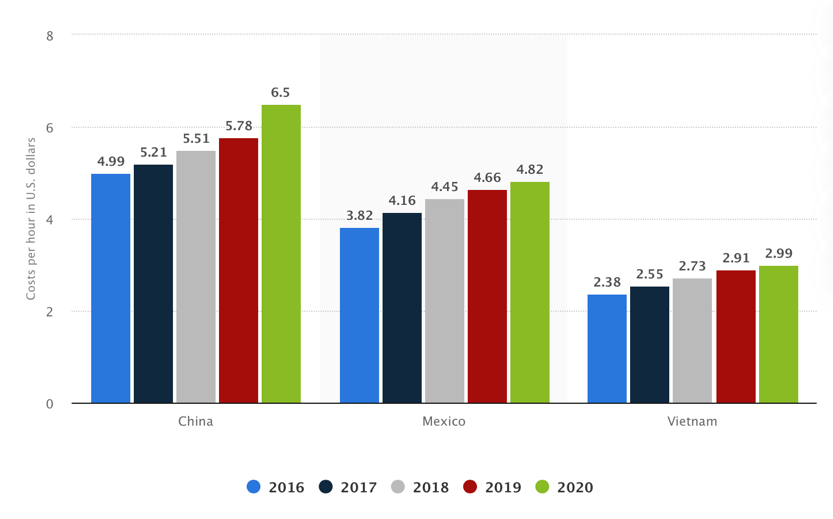
Social Demands
In addition, an intriguing factor influencing Apple’s strategy is the social mood. By now, it is difficult to identify the nature of the development of global ideas that qualitatively change the social structure of all humanity. It seems that the sources of such relevant and hotly debated ideas as feminism, racism, and tolerance should be recognized as the historical heritage and the natural evolution of human thought. One day, in the process of developing cognitive capital, humanity had to come to recognize the equal civil rights of all individuals without reference to their gender, ethnicity, or worldview characteristics. At the same time, in order to remain relevant to the agenda and thus an essential competitive advantage, Apple must meet the unique expectations imposed on it by society in a timely manner.
Culturally Sensitive Approach
The culture-oriented approach is also an extremely important factor for a modern international company. It should be noted that this aspect includes two areas at once: internally and externally. As a large, intercontinental company, Apple must ensure a fair, but not equal, level of quality of work for all employees. In more detail, the working conditions, wage levels, and compensation systems relevant to the American may be of little use to employees from Asian regions. Thus, a company should take care to sufficiently match the employee’s cultural background with the quality of benefits received.
A similar statement is typical of the external environment since price offers, advertising campaigns, and product lines must be suitable for the market of a particular region. In particular, there is no point in showing an American-oriented commercial to a European resident because the difference in mentality will not win the trust of the consumer. The same applies to products: the credit program from Apple and Goldman Sachs that is popular in the US is effective only in the Americas, so developing this program for other regions may be a risky and ultimately ineffective strategy (Theodorou and Dignum, 2020). As a bottom line, the cultural background of the market is extremely important and has a significant impact on the business agenda at Apple.
Inflation Rate
Additionally, the inflation rate has a significant impact on Apple’s policy. Since the brand has enormous financial resources at its disposal — it should be recalled that Apple is the most expensive company in the world — their depreciation can be a problem for business. Higher inflation naturally reduces the liquidity of the company and has the potential to reduce the profitability of production. As a result, with significant inflation or even hyperinflation, Apple runs the risk of being under pressure. If not managed properly, this will lead to the financial collapse of the company.
A Focus on Technology
Finally, a critical factor in Apple’s social agenda is its focus on technology. Of course, there is no doubt about brand leadership’s deep focus on innovation and development, but this focus must be in line with the demands of society. For example, Figure 3 shows that there has been a linear increase in the number of individuals using a smartphone over the past nine years. Since this number will naturally increase, Apple needs to build its production strategy so as not to show a shortage of goods. At the same time, it is evident that the innovative component of social life will continue to be more closely integrated into everyday life, which means that the company’s commitment to technology must intensify.
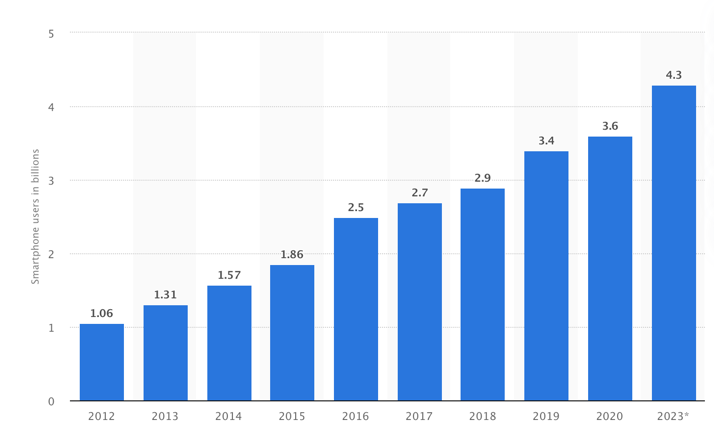
Literature Review
An excellent academic strategy to summarize both known information and current industry trends is a literary review. This section critically analyzes relevant topical sources on the issue of key aspects shaping Apple’s current operations. The review assesses the conceptualization of such factors as the macroeconomic aspects of business, the knowledge economy, demographic and socioeconomic shifts, and technological drivers of the enterprise.
The Knowledge Economy
There is no doubt that the classical perception of economics is no longer relevant to modern society. The industrial processes of manufacturization have been replaced by global digitalization, where information has become a precious resource. This, in turn, has given rise to a new branch in the development of the economy, now called the knowledge economy (Hayes, 2021). For Apple, the knowledge economy is a formative discipline since the production of technological goods without the involvement of knowledge, engineering, and science is not seen as possible. In this regard, Skrodzka’s (2016) work, which showed the key predictors of the knowledge economy, is particularly appealing.
More specifically, Figure 4 shows that without an economic regime, quality education, human resources, commitment to innovation systems, and advanced information infrastructures, building a knowledge economy would not be possible. Thus, the five fundamental pillars are necessary to build a qualitatively new economic model that is a catalyst for economic prosperity. A similar model of knowledge economy development is found in the works of Leydesdorff (2012), in which three main predictors of such an economy were shown (Figure 5). In more detail, it has been studied that this model of the economy is based on a competent integration of geography, knowledge, and economy. It seems obvious that this model does not consider human capital as an important component of modern business, and therefore the use of this scheme cannot fully reflect the current agenda.
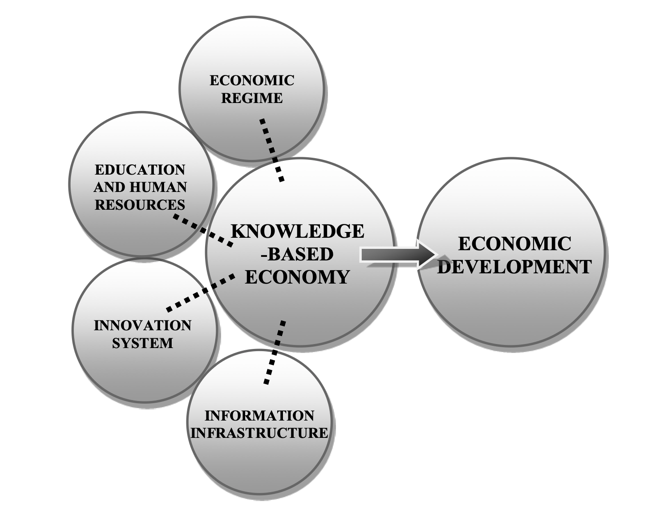
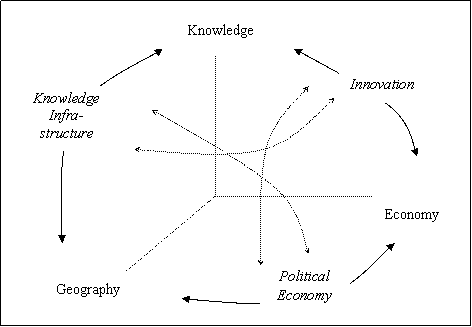
Having identified the key components of the modern economic model that develops a global market, it is appropriate to assess whether such a system is viable. Critical study of the new concept is devoted to a large number of academic papers, and most of the authors emphasize the positive effect of the knowledge economy. For instance, Dima et al. (2018) showed that a commitment to technology and a focus on human development in the context of large European companies played a decisive role in the development of market competition.
In this sense, it is relevant to notice the increased role of human beings in a modern company. In particular, Bogoviz et al. (2017), it was confirmed that the individual is gradually no longer perceived as an ordinary productive resource, but instead, their intellectual and creative potential is taken into account.
The aforementioned aspects of the knowledge economy are also true for Apple, which annually demonstrates the development of programs aimed at both increasing employee knowledge and cultural and historical recognition. One need only refers to the company’s official website to identify the core values perfectly covered by the requirements of the knowledge economy (Training, 2021). The successful combination of the terms “innovation” and the appeal directly to the user epitomizes the deep commitment of the company’s management to the idea of the supremacy of man in the construction of a new economic model (Figure 6).
And it is pertinent to note that the professional training strategies for young employees were embodied more than a decade ago, since the founding of Apple University, the large corporate unit responsible for improving employee competence (Chen, 2014). This data, coupled with the company’s built information infrastructure — called the ecosystem — suggests that Apple meets the key requirements of the knowledge economy.

Macroeconomic Factors
This section critically examines the critical effects of macroeconomics on Apple’s business strategy. Macroeconomic factors are defined as activities aimed at ensuring and maintaining the stable functioning of the national economy and shaping the growth and development trends of the enterprise. This includes the global market situation, resource utilization, geographic factor, and national agenda.
One of the most significant macro-environmental factors limiting the operation of any enterprise is the use of resources. There is no doubt that even with the most effective management, a lack of resources will have an inhibiting effect on operational activity. This statement is also true for Apple since limited materials, namely silicon semiconductors, are used to produce electronic devices. Once the amount of mined semiconductors is no longer sufficient for mass production of smartphones, Apple will find itself in a problematic situation of difficult choices. Consequently, the company’s dependence on the prevalence and ease of processing natural resources is an important limiting factor.
Another macroeconomic influence is the global agenda and, in particular, the COVID-19 pandemic. Severe restrictive measures, social distancing, and remote working requirements have forced management to close the company’s retail branches in the second quarter of 2020, which has undoubtedly affected operational efficiency (Clover, 2020). On the other hand, the restrictions also affected the manufacturer’s plants, which means that supply chains and lead times were damaged. As a result, this led to massive delays in the delivery of devices, so that consumers had to wait weeks for the goods after online payment in the online store.
At the same time, an alternative effect of COVID-19 should be acknowledged: finding themselves in a home learning and working environment, millions of people around the world felt the need for quality equipment, be it a laptop or a tablet. In turn, this influenced sales growth, and Apple managed to achieve record numbers for the fourth quarter of 2020 (Horwitz, 2020). Moreover, sales growth even exceeded the relevant period for late 2019, when the pandemic had not yet occurred, which may indicate the real need of users for quality technology at a remote operation.
Among others, the studied company’s operations are influenced by the demographic shifts seen in the regions where the tech is sold. Earl et al. (2017) refer to such shifts as dynamic population shifts related to a country’s economic development. Consequently, the effects of demographic shifts are most prominent in developing countries. In the context of Apple, this has two important aspects.
On the one hand, China’s demographic shift leads to a gradual decline in its population (Figure 7), as shown by Myers, Wu, and Fu (2020). In turn, the expected decline in headcount could affect the operational efficiency of the technology company, and it is therefore in the interest of Apple management to take care of strategic action plans in case delays from the manufacturing plant increase. That said, the demographic shift is known to be associated with the economic development of a region, which means that China’s apparent population decline is explained by the prosperity of the state’s economic system (Docquier et al., 2019). Turning to Figure 2 further confirms this: the increase in hourly wages for employees is consistent with the economic development of region.
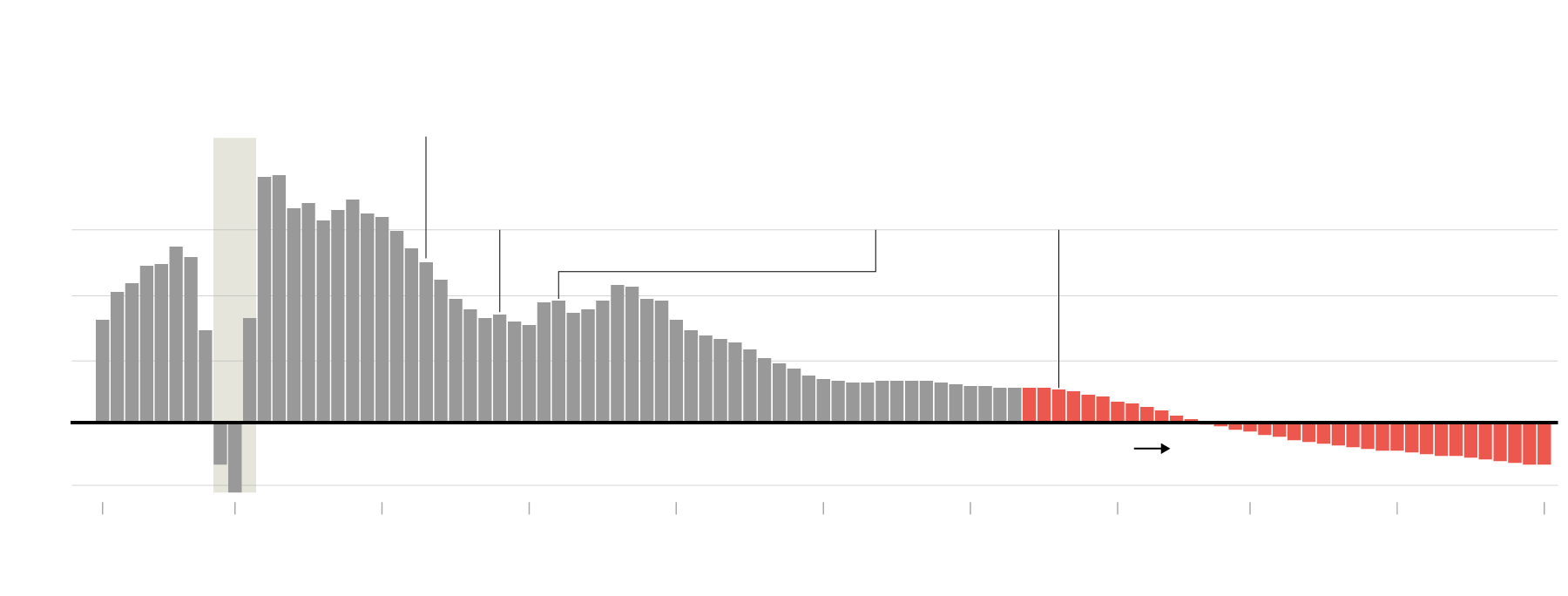
It should be clearly understood, however, that demographic shifts are in many ways prerequisites for more considerable root changes in society. Socioeconomic shifts, or otherwise social shifts, are perceived as broad societal changes initiated by a set of factors (Foster and Frieden, 2017). In the context of social relations, such transformations modify the nature of human relationships through the disruption of the stability of cultural institutions. For the entire developed world, illustrative examples of such changes have been the shift in perceptions of the LGBTQ+ community from a repressive-suppressive model to a tolerant-approving one.
Apple could not stay away from such a pressing agenda: newsletters and new accessory lines, and investments in developing community support programs have become basic leadership practices (Figure 8). Beyond the apparent interest in maintaining relevance and resilience, such business strategies aim to actually help people who require exceptional social support.

In the context of economic shifts, a key catalyst for these transformations is the technological advances made daily by the company’s engineers. Current-day inventions that have become routine might have seemed fantastic a decade ago: this is how the exponential growth of technology works: as shown in Figure 9. The natural development of technology is an essential driver of economic shifts for entire regions, as progress initiates the intellectualization of society. In turn, the growth of a population’s intellectual capital means an increase in the market value of wages. Such workers are more valued by managers, which means that companies must compete for them. Thus, the scientific and technological development of a region’s capabilities ultimately leads to its economic prosperity.

Technological forces, however, are not distinctive in themselves but also represent a dynamic model made up of many subcomponents. A reference to Faustino, Francisco, and Puentes-Rivera (2019) makes clear the multicomplexity of the innovation system (Figure 10). Furthermore, even a cursory analysis of the company makes it clear that Apple supports the ideation of all components. In addition to the technological boons available, Apple is known to invest in the development of augmented reality tools and technologies, generically referred to as the Internet of Things. Consequently, there is no reason to doubt the technological forces guiding the vector of brand development.
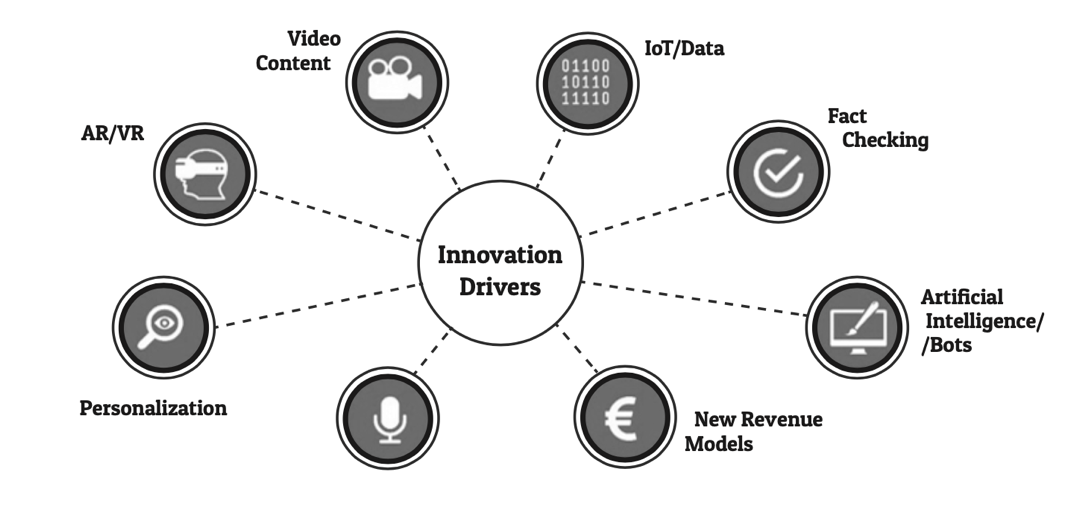
Legal and Political Factors
The limiting factors of the macro-environment, in addition to the aspects already discussed, include legal and political mechanisms. It should be recognized that any company must operate within the framework of legal regulations, which in itself already imposes constraints on the business freedom of the enterprise. In the case of Apple, the diversity of such legal cultures must be understood since the legislative frameworks of diametrically different states differ from each other.
Tax Payments
Apple’s tax policy is a susceptible topic because due to the significant cash turnover, the management has to give much money to the state. Of course, Apple has little interest in such expenses, and therefore the company uses legal loopholes in the legal practice of the states. For example, in the United States, Apple is forced to keep the bulk of its income (90%) in offshore accounts in order to reduce the tax burden on the company by the local government (Hoxie, 2018).
That said, this arrangement is not fraudulent and does not mean that Apple is waiving its tax obligations. On the contrary, in each country where the company’s products are marketed, Apple pays a tax base to local governments. Specifically, profits from the purchase of a device in the European market are first taxed locally and then delivered to the company. The amounts payable are quite substantial, which is why the company has been an active advocate for international financial reform of simplified taxation since its founding (Apple, 2017). Thus, tax payments are an essential constraint on the business activities of the company in question.
Legislative Framework
Apple’s policies are also affected by the need to follow local laws. The company’s management must continually take care to ensure that the products released, promotional campaigns, and statements are in line with the legal environment in which the products are sold. Apple seems to be following these rules, as several pieces of information at once confirm this compliance policy. For example, the Apple Watch functionality released in the U.S. (in particular, ECG) has only recently become available to users from other countries. This delay was due to the inability to use the electronic watch to take electrocardiograms in countries where the healthcare system does not standardize such methods (Bell, 2018).
At the same time, Apple has consistently lost courts to governments that disapprove of the company’s strategic decisions. In more detail, the removal of the charger from the packaging kit explained as a concern for the environment was not welcomed by the Brazilian government, which considered such an action a violation of consumer rights law (Mlot, 2021). Finally, recent actions in Russia related to the legal requirement to pre-install domestic software on phones for sale perfectly demonstrates that Apple must follow local laws in order to preserve the market (Dmitriev, 2021). As a result, the legal burden is an essential factor in Apple’s activism.
Privacy Requirement
An intriguing aspect of Apple’s activity is the conflict between the requirement of complete privacy of user actions and local law enforcement requests to help find criminals. On the one hand, Apple promises that any data collected is anonymous, and attempts to cooperate with the FSB (or counterparts in other countries) are ineffective. Thus, the user’s trust in the system is an absolute priority for Apple. On the other hand, many governments are trying to pressure large companies through bans and restrictions to encourage management to cooperate. According to law enforcement, the data collected should be handed over to agencies to decrypt and de-anonymize the criminal user. Thus, a significant challenge for Apple is finding effective strategies for balancing national security and user trust.
Antitrust Law
It is in the interest of any country to create a dynamic market that tends to increase the competitiveness of companies. Competition, in turn, leads to an increase in the quality of goods or services and is therefore of crucial importance to the end consumer (Ghetti, 2018). States’ antitrust laws aim to inhibit market shifts toward large companies and thus maintain helpful competition.
Although each market is characterized by its own formulation of antitrust laws, in general, they aim to discourage discriminatory pricing and monopolistic merger. In the context of Apple, such mechanisms are crucial because such a significant player in the market arena cannot help but be suspected of monopolistic manipulation. News outlets often report open violations of countries’ antitrust laws (Fung, 2013). Consequently, the company is restricted in its own actions and is thus forced to adjust to the laws of different countries.
Intellectual Property Claims
One of the results of the creative activities of the company is intellectual property, which is protected by the laws of the country. Apple is among the leaders in the number of registered patents, and the number of patents, in general, is growing (Figure 11).
In order to fix the right of ownership of developed technologies, Apple applies to the patent bureau for registration every year. Moreover, in recent years, the company’s patent policy is aimed at increasing the number of registrations even for those technologies and products that are unlikely to reach the consumer. This strategy can be explained by the need to legally consolidate the status of the creator of intellectual property to sell the possibility of using the mechanism to other organizations. Consequently, combined with a general interest in registering marketed products, Apple shows an interest in long-term investment in technologies and tools for the b2b vector.
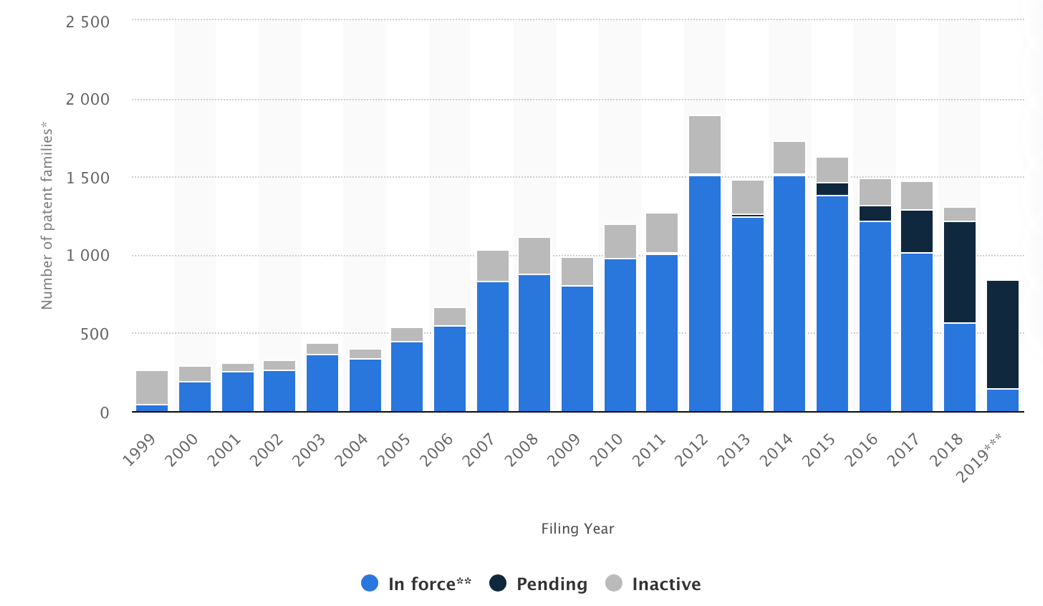
In addition, every company is interested in supporting initiatives that qualitatively facilitate business operations. The endless restrictions, reforms, and bans can put too much pressure on an enterprise, and therefore political lobbying is necessary. There is no unified concept of political lobbying, and researchers tend to have unique interpretations of the term. For example, Jia (2018) understands the phenomenon as the actions of organized pressure groups under legislative and other bodies that exert targeted influence on power structures to realize their specific interests.
In the context of Apple, such lobbying is a valuable mechanism to promote convenient economical and political laws. Figure 12 confirms these arguments and shows an almost linear growth of the annual budget of the company spent on the implementation of political lobbying. The figure also shows the growth of the number of agents engaged in lobbying: this together gives an idea of how vital it for Apple is the long-term development of its own initiatives.
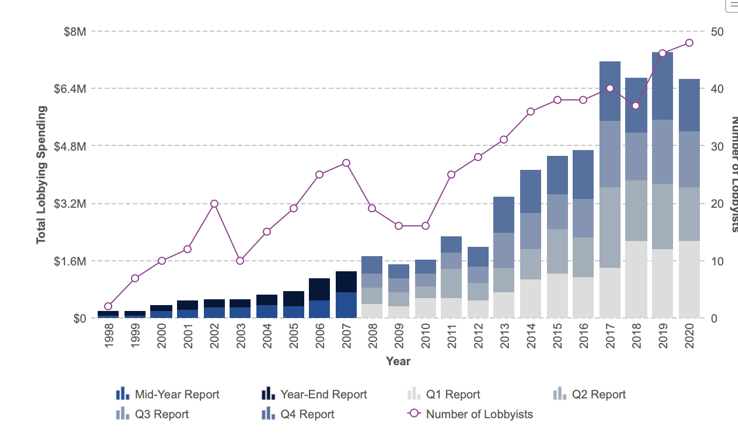
Conclusion
As shown in this research paper, Apple has sufficient openness and tolerance to the external environment and therefore finds itself under the influence of factors. Most of the external and internal factors are able to influence the organizational structure qualitatively, and therefore the company management should be interested in managing them. The paper consistently examined the critical socio-economic, macroeconomic, technical, demographic, political, and legal aspects that limit Apple’s business freedom. It was shown that, in general, Apple is able to control and effectively manage the constraints.
Moreover, it is appropriate to conclude that Apple is highly dependent on legal and political factors in the market in which it sells its products. For strategically correct management of operational processes, brand management must take into account the intellectual and legal peculiarities of the region, the local legislation, and the taxation system. At the same time, it is within its resources to lobby for legislation that facilitates business activities. Consequently, Apple’s long-term development is focused not only on maintaining compliance with local market laws but also on forming a renewed economic and political system.
Key recommendations relevant to Apple’s business strategy include maintaining and multiplying current strategies to defend against external threats. Among others, it is in management’s power to use current operational strategies to extend brand wiggle room into new markets and strengthen its presence in current ones. The company must maintain its competitive advantage in terms of product quality and the ability to integrate easily. Therefore, it is necessary to continue the direction of innovative development at an accelerating pace. Finally, the company should take care to develop political lobbying to initiate the development of convenient bills.
Reference List
Apple (2017) The facts about Apple’s tax payments. Web.
Apple (2020) As Pride goes virtual, Apple Watch Pride Edition helps community and advocacy continue worldwide. Web.
Apple Inc. (2020) Form 10-K. Web.
Bell, K. (2018) You’ll be able to enable Apple Watch 4’s ECG outside the U.S. Web.
Bogoviz, A.V., Ragulina, Y.V., Alekseev, A.N., Anichkin, E.S. and Dobrosotsky, V.I. (2017) ‘Transformation of the role of human in the economic system in the conditions of knowledge economy creation,’ International Conference on Humans as an Object of Study by Modern Science, 42(2) pp. 673-680.
Chen, B. X. (2014) Simplifying the bull: How Picasso helps to teach Apple’s style. Web.
Client profile: Apple Inc. (2020) Web.
Clover, J. (2020) COVID-19 coronavirus: Impact on Apple’s iPhone, Mac and WWDC. Web.
Dima, A.M., Begu, L., Vasilescu, M.D. and Maassen, M.A. (2018) ‘The relationship between the knowledge economy and global competitiveness in the European Union,’ Sustainability, 10(6), pp. 1706-1718.
Dmitriev, D. (2021) Apple won’t leave Russia iPhone maker bows to new government-imposed app requirements. Web.
Docquier, F., Kone, Z.L., Mattoo, A. and Ozden, C. (2019) ‘Labor market effects of demographic shifts and migration in OECD countries,’ European Economic Review, 113, pp. 297-324.
Earl, C., Taylor, P., Roberts, C., Huynh, P. and Davis, S. (2017) ‘The workforce demographic shift and the changing nature of work: Implications for policy, productivity, and participation,’ Age Diversity in the Workplace, 1-13.
Faustino, J. P. J., Francisco, B. and Puentes-Rivera, I. (2019) Communication, media and creative industries in the digital era. Web.
Foster, C. and Frieden, J. (2017) ‘Crisis of trust: Socio-economic determinants of Europeans’ confidence in government,’ European Union Politics, 18(4), pp. 511-535.
Fung, B. (2013) Apple’s violation of antitrust law, explained in 6 bullet points. Web.
Ghetti, R. (2018) ‘Unification, Harmonisation and Competition in European Company Forms,’ European Business Law Review, 29(5), 1-18.
Hayes, A. (2021) Knowledge economy. Web.
Higgins, T. (2020) Apple’s sales rise in pandemic, but pressure remains for breakout holiday season. Web.
Horwitz, J. (2020) Apple reports record $64.7 billion revenue in Q4 2020 despite iPhone delay. Web.
Hoxie, J. (2018) Commentary: Apple avoided $40 billion in taxes. Now it wants a gold star? Web.
Jia, N. (2018) ‘The “make and/or buy” decisions of corporate political lobbying: Integrating the economic efficiency and legitimacy perspectives,’ Academy of Management Review, 43(2), pp. 307-326.
Jones, K. (2021) The top 50 most valuable global brands. Web.
Leydesdorff, L. (2012) ‘The knowledge-based economy and the triple helix model,’ arXiv preprint arXiv, 1201.4553, pp. 1-8.
Mlot, S. (2021) Brazil fines Apple $2M for shipping iphones without a charger. Web.
Myers, S. L., Wu, J., and Fu, C. (2020) China’s looming crisis: A shrinking population. Web.
Nellis, S. (2020) Exclusive: Apple targets car production by 2024 and eyes ‘next level’ battery technology — sources. Web.
O’Dea, S. (2021) Smartphone users worldwide 2016-2023. Web.
Rawlinson, N. (2017) History of Apple: The story of Steve Jobs and the company he founded. Web.
Reiff, N. (2021) Top stocks of April 2021. Web.
Skrodzka, I. (2016) ‘Knowledge-based economy in the European Union–Cross-country analysis. Statistics in Transition,’ New Series, 17(2), pp. 281-294.
Spainhower, K.B., Cliffe, R.N., Metz, A.K., Barkett, E.M., Kiraly, P.M., Thomas, D.R., Kennedy, S.J., Avey-Arroyo, J.A. and Butcher, M.T. (2018) ‘Cheap Labor: Myosin fiber type expression and enzyme activity in the forelimb musculature of sloths (Pilosa: Xenarthra),’ Journal of Applied Physiology, 125(3), pp. 799-811.
Szmigiera, M. (2021) Manufacturing labor costs per hour for China, Vietnam, Mexico from 2016 to 2020. Web.
Theodorou, A. and Dignum, V. (2020) ‘Towards ethical and socio-legal governance in AI,’ Nature Machine Intelligence, 2(1), pp. 10-12.
Training. (2021) Web.
Wunsch, N. (2020) Number of Apple patents by filing year and legal status worldwide 1999-2019. Web.
